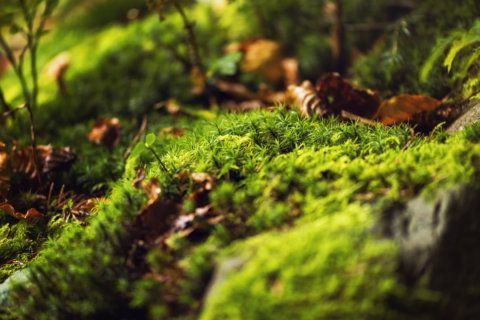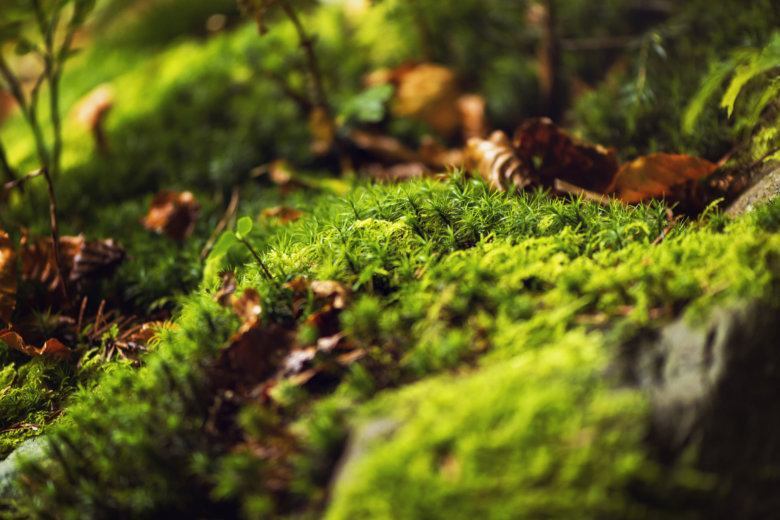
She wants to get rid of moss …
Moss continues to be a hot topic!
Linda in Fair Oaks, Virginia, writes:
I have several areas of deep shade around the house. Those areas look green from a distance, but only because they are covered by moss. Even a professional lawn service hasn’t been able to get grass to grow there. I’m giving up on grass and going with ground cover. My question is, which ground cover to choose that isn’t difficult to keep clean without damaging it when the tree leaves start falling and need raking?
The classic choice is pachysandra, Linda.
But no ground cover is immune to the rigors of raking. A leaf blower with a reverse setting is the perfect tool for this chore. You suck up the leaves without bending over, a metal wheel inside the device shreds them, and they end up in the collection bag, ready for mulching or compost making.
… He wants her to embrace it
Barnaby in Vienna has a different take on moss.
I want to make a case to Michelle in Olney [Maryland] who complained of moss in a previous Garden Plot:
Don’t be afraid to embrace the moss! In every way you can think of, moss is far superior than the grass you’re trying to grow.
- It retains moisture for your garden.
- It does not require any mowing or the application of herbicides or pesticides.
- Moss is a great home for beneficial insects.
- That moss will suck up more carbon dioxide than your lawn ever could.
I could go on, but I want to end with an appeal to the child in you. … If you have a special place in your heart for summer nights spent catching fireflies, then please let your moss grow! These moisture-loving insects see moss as the ideal nursery for their young. Save the moss, save the lightening bugs!
Stones make a miserable mulch
John in Marriottsville, Maryland, writes:
A few years back, I removed the wood mulch from my garden beds and laid down decorative stone in its place. I just liked the look of the stone better. Before putting down the stone, I put down two layers of matting to prevent weeds from coming up. Well, the matting has since deteriorated and the weeds are rampant. Do you have any suggestions for me to re-do the garden beds so I can keep the stone but prevent the weeds? I really like the look of the stone and am willing to remove it temporarily if there’s something I can use in lieu of the matting. I appreciate your advice!
Sorry John, but weed mats are notorious for encouraging weeds to grow. And anything else will either decompose like the weed mats or prevent rain from getting to the plants.
But I blame the stone. Stone makes a miserable mulch. Dirt collects in the areas between the stones, making a fertile ground for wind-spread weed seeds (and seeds “planted” by birds up in the trees). It is impossible to keep a bed of stones weed-free.
Try pine straw instead; it looks nice and is tough on weeds.
Old bathtubs make great planters
Linda in DC writes:
I have a 5-foot-long claw foot porcelain bathtub that I salvaged and would like to turn into a patio garden planter with herbs and veggies. What materials do I need to place in the inner tub prior to adding the soil and plants? And what assortment of herbs, vegetables and flowering plants that keep insects away do you suggest? I live in D.C. and the weather is turning cool so I will start my planting project in the spring.
No plant in a pot will keep insects away, Linda. We’ll discuss this in depth below.
But the good news is that this is a great time to plant your big tub. Put screening over the drain hole and maybe a few inches of rocks or stones in the bottom so you don’t need as much planting mix. Then fill the tub with a one-third compost, one-third potting soil and one-third perlite. No garden soil — it’s full of weeds.
Then plant it with lettuce and other cold-hardy salad greens, you’ll get great harvests from mid-September through January.
Insect repelling plants
In our last thrilling episode, Linda in D.C. was re-purposing an old bathtub into a planter and wanted to know what she could grow in it to keep insects away.
The bad news is that no plant can repel insects on its own, but many herbs do make effective insect repellents if you grow them, crush up the leaves and rub them on your skin.
Lemon thyme has been shown to be the most effective insect repelling plant you can grow in our climate. It’s as effective as some concentrations of DEET! It’s also a very attractive plant, but it is tiny, so growing a large amount can be a challenge.
The best bet would probably be lemon balm. It’s so cold-hardy it would survive winter outside in your tub, it grows really big really fast and is very effective as an insect repellent.
Being a member of the mint family, lemon balm can become invasive when grown in the ground, so having it in a big container makes it the perfect plant for your needs.
Mike McGrath was Editor-in-Chief of ORGANIC GARDENING magazine from 1990 through 1997. He has been the host of the nationally syndicated Public Radio show “You Bet Your Garden” since 1998 and Garden Editor for WTOP since 1999. Send him your garden or pest control questions at MikeMcG@PTD.net.








